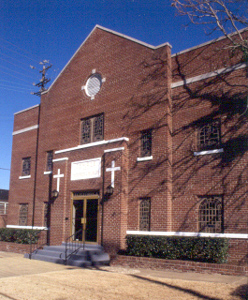
Church of God in Christ (COGIC)
Estimated to be the second largest black religious denomination in the United States, the Church of God in Christ is characterized as a Pentecostal denomination. Followers of Pentecostal faiths embrace the spiritual gifts that early Christians first received on the day of Pentecost (the fiftieth day after the Resurrection of Jesus). COGIC emphasizes all the gifts of the Spirit, particularly speaking in tongues, which is testimony to the baptism of the Holy Spirit.
Although the convening of the first Pentecostal General Assembly of the church in Memphis during November 1907 is regarded as the official founding date, the antecedents of the Church of God in Christ date to much earlier. COGIC’s architect was Charles Harrison Mason, who was born on September 8, 1866. In November 1878, at the age of twelve, he became a professing Christian at the Mt. Olive Missionary Baptist Church near Plumerville, Arkansas. In 1893 the Mt. Gale Missionary Baptist Church in Preston, Arkansas, licensed Mason into the ministry. During his first year, Mason became intrigued with the doctrine of sanctification.
In 1895 Mason met C. P. Jones, J. E. Jeter, and W. S. Pleasant. These radical holiness preachers conducted a revival in Jackson, Mississippi, the following year. The dogmatic teachings of Mason resulted in his alienation from the Baptist Church, but this did not stall his ministry. His meetings continued to take place in an abandoned cotton gin house in Lexington, Mississippi. Though Mason had separated from the established church, persecution still followed him. Five pistol shots and two double barreled shotgun blasts disrupted one meeting, wounding several worshippers.
Such attacks failed to discourage Mason and his followers. Instead, they founded the holiness sect known as the Church of God. In 1897, while walking along a street in Little Rock, Mason envisioned the name “Church of God in Christ,” and the name change gave Mason’s church its own distinct identity.
The year 1907 marked a maturation point in Mason’s efforts of establishing a distinctive church when he and Elders D. J. Young and J. A. Jeter attended the Azusa Street Revival in Los Angeles. There, under the teaching of W. J. Seymour, Mason became a believer in the outpouring of the Holy Spirit and in tongues as witness to this baptism. Upon his return to Memphis, where his church was now located, Mason proclaimed speaking in tongues a New Testament doctrine. Jones split with Mason over this issue and led the non-Pentecostal faction of COGIC, which eventually became known as the Church of Christ (Holiness), U.S.A. Mason’s followers retained the COGIC name and convened the first Pentecostal General Assembly in Memphis in 1907. Representatives from twelve churches attended the initial meeting.
Between 1907 and 1914 the Church of God in Christ was the only incorporated Pentecostal body in the nation. Mason ordained both white and black clergy, since both needed licenses of ordination, but whites and blacks generally gravitated to separate congregations. Many of the white clergy ordained by Mason helped to form the Assembly of God Church in 1914.
When Mason died in 1961, a brief leadership crisis ensued. Mason’s son-in-law, J. O. Patterson Sr., became presiding bishop in 1968. Since then an orderly and timely succession of leadership has resulted; Louis H. Ford and Chandler Owens occupied the Presiding Bishopric in 1989 and 1995, respectively. In November 2000 Gilbert E. Patterson, of the Temple of Deliverance COGIC in Memphis, was elected presiding bishop. The World Headquarters of the Church of God in Christ is in Memphis. At Mason Temple there in 1968 the Reverend Martin Luther King Jr. gave his final major public address, the “I’ve Been to the Mountaintop” sermon, the night before he was assassinated at the Lorraine Motel.
Suggested Reading
C. Eric Lincoln and Lawrence H. Mamiya, The Black Church in the African American Experience (1990)



